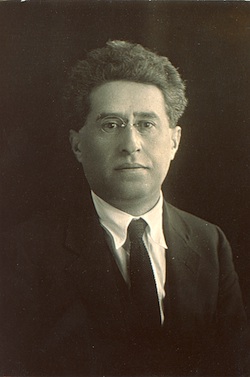By Charlene Kahn, Special to JTNews
It’s a real mystery: How did Samuel Solomonovich Koteliansky become close to the major figures in modern English literature of the early 20th century? He lived through the eruption of two world wars, genocide of his people, endured anti-Semitism. Yet through his peripheral yet intense connection with members of the Bloomsbury group, this shtetl-born Jew added something special that is detailed in the publication of University of Washington professor Galya Diment’s A Russian Jew of Bloomsbury: The Life and Times of Samuel Koteliansky.
Released by academic publisher McGill-Queens University Press, the hefty hardcover contains the life story of S.S. Koteliansky, known as “Kot” to his British friends.
It sounds like a familiar enough story. Koteliansky, an Eastern European Jew from Ostropol, becomes educated enough to push beyond the limitations imposed on minorities, especially Jews, and flees the deadly discrimination and terror of Czarist Russia. He leaves to make his fortune in London, which still proves anti-Semitic, but without the murderous pogroms that plague his homeland.
His colleague at London’s Russian Law Bureau invites Koteliansky for a two-day hike in England’s Lake District. Joining the men are two other friends, an engineer and a writer. Kot becomes friends with the writer, whose full name was David Herbert Richards Lawrence — better known as D. H. Lawrence. From that moment, Samuel Solomovich Koteliansky’s professional and social life were forever changed.
Lawrence’s social circle widened to include Kot. Though his name became Anglicized, he did not. He maintained an “insider-outsider” social and working relationship with various members of the Bloomsbury Group. In fact, Kot was frequently referred to as “the Jew.” However, Diment also provides broader evidence about the complex relationships between Jews and gentiles of the time: Imagine D.H. Lawrence at a Shabbat dinner; members of the Bloomsbury Group eating latkes; Kot recommending a Hebrew dance group touring London. All true.
For a time, Kot worked for Virginia and Leonard Woolf’s Hogarth Press, translating several major Russian works of literature. His translations included Gorky, Tolstoy, Dostoevsky, Chekhov. In memory of his mother Beila, Kot was able to publish two of her stories, “Maimonides and Aristotle” and “The Salvation of a Soul,” about the founder of the Chassidic movement. Though Kot traveled far beyond his beginnings, he never forgot his origins.
Besides Lawrence, Kot maintained friendships with other notable authors, writers, artists and even the occasional aristocrat of the time: Katherine Mansfield, H.G. Wells, May Sarton, Mark Gertler, Lady Ottoline Morrell. Intense friendship was his calling, but he was not hesitant about strongly communicating his dislikes. Woe to those who fell out of favor with this “dark Russian.” Lawrence’s wife Frieda was in this category from the very beginning.
One unfortunate limitation Kot could not escape from was his reoccurring, self-described “black mood” that worsened, eventually resulting in a suicide attempt in later years, and electroshock therapy. But his circle of friends, primarily younger women, cared for him until his death at 75. Diment believes Kot was probably bipolar, given his symptoms. One could only imagine how different his life could possibly have been with contemporary medical treatments.
The book gives an inside perspective, based on original documents, interviews and primary correspondence between Kot and his coterie of friends, as well as relatives who emigrated to Canada. Some material is published for the first time. Photographs accompanying the text are generous in number and help the reader relate to the subjects.
Descriptions of Koteliansky’s early life and family origins will resonate with Jews descended from similar shtetl ancestry, or those interested in learning more about that lost era. “Shmilik,” the book’s first chapter, is a real gift for the reader. Here Diment’s dedicated research and understanding of Russian-Ukrainian history allows her to weave together the various strands of history and family lore, fact and folkways into a very readable chapter. The extensive notes show the lengths to which Diment goes; no straying into Fiddler-style nostalgia for her.
Galya Diment’s day job as chair and professor in the UW’s Slavic Languages and Literature department gave her limited time to work on the book, but grants helped her proceed with research. Diment’s sensitivity and interest in her subject stems from her own self-described love of English literature; her research (traveling to modern-day Ukraine is invaluably aided by her native fluency in Russian and understanding of Ukrainian; her own family’s legacy as Leningrad Jews who experienced, survived and left the Soviet Union speaks for itself).
During our interview, Professor Diment shared some stories about her own background. With rabbinic ancestry on her father’s side and Bolshevik on her mother’s, Diment presents a mixture of differing Jewish experiences this reviewer thinks would make for a very interesting read. This might be the time, following the success of Forward writer Gal Beckerman’s award-winning When They Come for Us We’ll Be Gone.
The story of an immigrant life takes on a heightened dimension when that immigrant becomes close to literary stars of the era. This was Kot’s world, this circle of writers, artists and other assorted bohemians who influenced the development of modern English literature and furthered the popularity of Russian literature as well.
Almost one quarter of the 437-page book contains supporting materials: A chronology relating Kot’s life to historical events and thorough notes detailed by page sections — the “Who’s Who” reads like a playlist. It’s clear Diment did her homework for this friend of the stars of the day.
For Diment, the biography about Koteliansky was a true “labor of many loves and many years” — 10 years in all, she wryly notes. Let’s hope we don’t need to wait another 10 for her next book.
